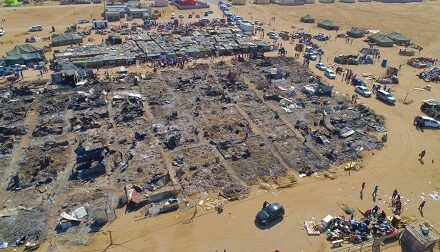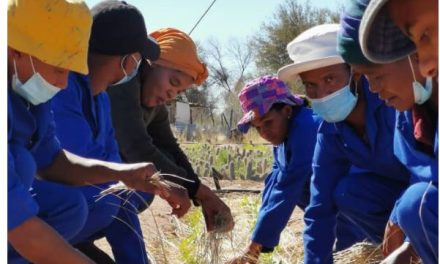
Ozonahi Conservancy learns how to prepare “boskos” to sustain livestock during prolonged droughts

A survival trick practised by just about every commercial farmer, has now been implemented at Ozonahi Conservancy to teach the residents how to manufacture their own animal feed from natural bush. In the trade, this form of sustenance is known as “boskos.”
In many instances, commercial farmers managed to survive the severe 2019 drought by preparing their own concoctions from natural bush, augmented with supplements and salt. The bush is chopped fine in a hammer mill and then processed into a palatable pellet which the animals take some time to get used to. Once they have become accustomed to the texture and the taste of the pellets, their condition improves rapidly, and most of the animals survive the drought.
A similar Bush to Feed project was implemented by the Ministry of Environment, Forestry and Tourism at Ozonahi, funded by the Environmental Investment Fund of Namibia.
Minister Pohamba Shifeta officiated at the handover ceremony, saying “Bush encroachment threatens natural habitats for animals and plants of the savannah ecosystem. Local bushes, such as blackthorn (Senegalia mellifera), are spreading massively at the expense of grass vegetation, especially in the Otjozondjupa Region. In Namibia, about 45 million hectares of agricultural land is infested with encroached bushes destroying the arable land and reducing its productivity”.
He further emphasized that farming communities and especially small farmers have the potential to contribute significantly to national food security as well as the national economic growth of this country. It is in our best interest to foster the conservation of our natural resources through a community-based natural resource management system as established by the Ministry of Environment, Forestry, and Tourism.
Situated in the Okakarara Constituency, the Ozonahi Conservancy was funded to the tune of N$ 2,498,835 under the Ecosystem-Based Adaptation investment window under the Empower to Adapt (EDA) project, which is centred around Creating Climate Change Resilient Livelihoods through Community Based Natural Resource Management in Namibia.
The Ozonahi Conservancy covers a total area of 320 400 Ha with an estimated population of 10,922 and approximately 90 villages. Residents of the conservancy derive their livelihoods from livestock farming with large and small stock, however, Farmers in the Ozonahi Conservancy area have been experiencing a decline in agricultural productivity due to a high rate of bush encroachment and the added pressure of overgrazing which has resulted in severe land degradation and mushrooming of Acacia mellifera (Omusaona/swarthaak) in livestock grazing areas and this causes more stress to farmers be it socially, financially and environmentally.
To date the project has benefitted 10,992 people through the acquisition of 4 chainsaws and accessories, 4 brush cutters and accessories, 4 Kalahari Chippers on trailers, an Agri Mixer machine, a pellet extruder, a tractor with trailer and a storage facility. Working as boskappers are 25 men from the Ozonahi settlements with another five people to mix and pack the boskos.












































